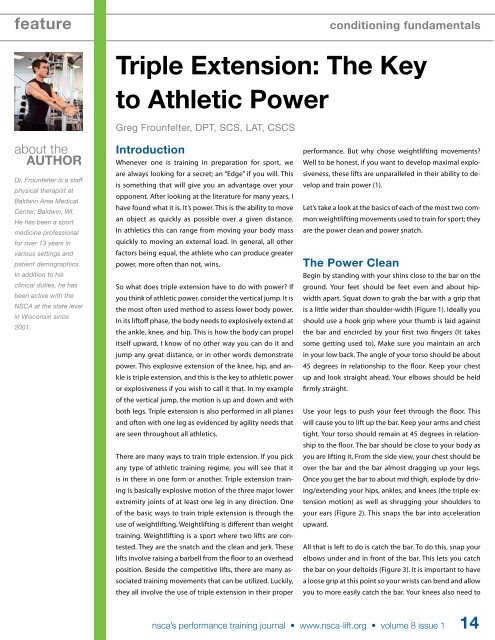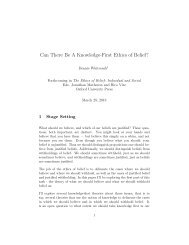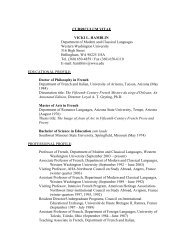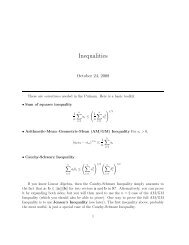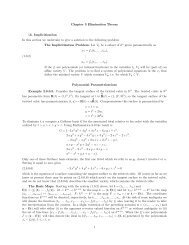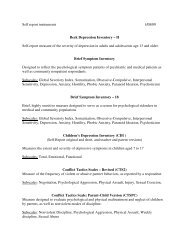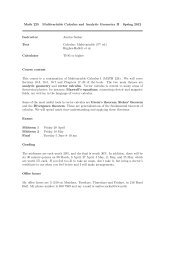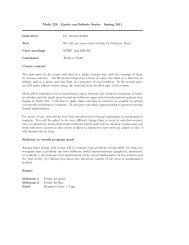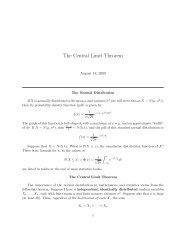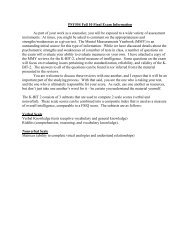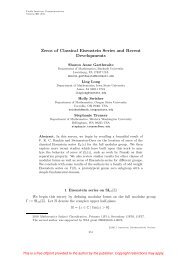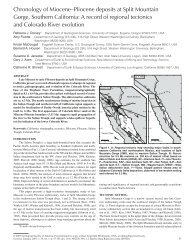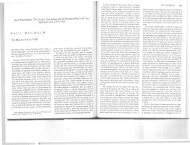Triple Extension - the key to athletic power
Triple Extension - the key to athletic power
Triple Extension - the key to athletic power
Create successful ePaper yourself
Turn your PDF publications into a flip-book with our unique Google optimized e-Paper software.
feature<br />
conditioning fundamentals<br />
<strong>Triple</strong> <strong>Extension</strong>: The Key<br />
<strong>to</strong> Athletic Power<br />
Greg Frounfelter, DPT, SCS, LAT, CSCS<br />
about <strong>the</strong><br />
AUTHOR<br />
Dr. Frounfelter is a staff<br />
physical <strong>the</strong>rapist at<br />
Baldwin Area Medical<br />
Center, Baldwin, WI.<br />
He has been a sport<br />
medicine professional<br />
for over 13 years in<br />
various settings and<br />
patient demographics.<br />
In addition <strong>to</strong> his<br />
clinical duties, he has<br />
been active with <strong>the</strong><br />
NSCA at <strong>the</strong> state level<br />
in Wisconsin since<br />
2001.<br />
Introduction<br />
Whenever one is training in preparation for sport, we<br />
are always looking for a secret; an “Edge” if you will. This<br />
is something that will give you an advantage over your<br />
opponent. After looking at <strong>the</strong> literature for many years, I<br />
have found what it is. It’s <strong>power</strong>. This is <strong>the</strong> ability <strong>to</strong> move<br />
an object as quickly as possible over a given distance.<br />
In <strong>athletic</strong>s this can range from moving your body mass<br />
quickly <strong>to</strong> moving an external load. In general, all o<strong>the</strong>r<br />
fac<strong>to</strong>rs being equal, <strong>the</strong> athlete who can produce greater<br />
<strong>power</strong>, more often than not, wins.<br />
So what does triple extension have <strong>to</strong> do with <strong>power</strong>? If<br />
you think of <strong>athletic</strong> <strong>power</strong>, consider <strong>the</strong> vertical jump. It is<br />
<strong>the</strong> most often used method <strong>to</strong> assess lower body <strong>power</strong>.<br />
In its lif<strong>to</strong>ff phase, <strong>the</strong> body needs <strong>to</strong> explosively extend at<br />
<strong>the</strong> ankle, knee, and hip. This is how <strong>the</strong> body can propel<br />
itself upward. I know of no o<strong>the</strong>r way you can do it and<br />
jump any great distance, or in o<strong>the</strong>r words demonstrate<br />
<strong>power</strong>. This explosive extension of <strong>the</strong> knee, hip, and ankle<br />
is triple extension, and this is <strong>the</strong> <strong>key</strong> <strong>to</strong> <strong>athletic</strong> <strong>power</strong><br />
or explosiveness if you wish <strong>to</strong> call it that. In my example<br />
of <strong>the</strong> vertical jump, <strong>the</strong> motion is up and down and with<br />
both legs. <strong>Triple</strong> extension is also performed in all planes<br />
and often with one leg as evidenced by agility needs that<br />
are seen throughout all <strong>athletic</strong>s.<br />
There are many ways <strong>to</strong> train triple extension. If you pick<br />
any type of <strong>athletic</strong> training regime, you will see that it<br />
is in <strong>the</strong>re in one form or ano<strong>the</strong>r. <strong>Triple</strong> extension training<br />
is basically explosive motion of <strong>the</strong> three major lower<br />
extremity joints of at least one leg in any direction. One<br />
of <strong>the</strong> basic ways <strong>to</strong> train triple extension is through <strong>the</strong><br />
use of weightlifting. Weightlifting is different than weight<br />
training. Weightlifting is a sport where two lifts are contested.<br />
They are <strong>the</strong> snatch and <strong>the</strong> clean and jerk. These<br />
lifts involve raising a barbell from <strong>the</strong> floor <strong>to</strong> an overhead<br />
position. Beside <strong>the</strong> competitive lifts, <strong>the</strong>re are many associated<br />
training movements that can be utilized. Luckily,<br />
<strong>the</strong>y all involve <strong>the</strong> use of triple extension in <strong>the</strong>ir proper<br />
performance. But why chose weightlifting movements?<br />
Well <strong>to</strong> be honest, if you want <strong>to</strong> develop maximal explosiveness,<br />
<strong>the</strong>se lifts are unparalleled in <strong>the</strong>ir ability <strong>to</strong> develop<br />
and train <strong>power</strong> (1).<br />
Let’s take a look at <strong>the</strong> basics of each of <strong>the</strong> most two common<br />
weightlifting movements used <strong>to</strong> train for sport; <strong>the</strong>y<br />
are <strong>the</strong> <strong>power</strong> clean and <strong>power</strong> snatch.<br />
The Power Clean<br />
Begin by standing with your shins close <strong>to</strong> <strong>the</strong> bar on <strong>the</strong><br />
ground. Your feet should be feet even and about hipwidth<br />
apart. Squat down <strong>to</strong> grab <strong>the</strong> bar with a grip that<br />
is a little wider than shoulder-width (Figure 1). Ideally you<br />
should use a hook grip where your thumb is laid against<br />
<strong>the</strong> bar and encircled by your first two fingers (It takes<br />
some getting used <strong>to</strong>). Make sure you maintain an arch<br />
in your low back. The angle of your <strong>to</strong>rso should be about<br />
45 degrees in relationship <strong>to</strong> <strong>the</strong> floor. Keep your chest<br />
up and look straight ahead. Your elbows should be held<br />
firmly straight.<br />
Use your legs <strong>to</strong> push your feet through <strong>the</strong> floor. This<br />
will cause you <strong>to</strong> lift up <strong>the</strong> bar. Keep your arms and chest<br />
tight. Your <strong>to</strong>rso should remain at 45 degrees in relationship<br />
<strong>to</strong> <strong>the</strong> floor. The bar should be close <strong>to</strong> your body as<br />
you are lifting it. From <strong>the</strong> side view, your chest should be<br />
over <strong>the</strong> bar and <strong>the</strong> bar almost dragging up your legs.<br />
Once you get <strong>the</strong> bar <strong>to</strong> about mid thigh, explode by driving/extending<br />
your hips, ankles, and knees (<strong>the</strong> triple extension<br />
motion) as well as shrugging your shoulders <strong>to</strong><br />
your ears (Figure 2). This snaps <strong>the</strong> bar in<strong>to</strong> acceleration<br />
upward.<br />
All that is left <strong>to</strong> do is catch <strong>the</strong> bar. To do this, snap your<br />
elbows under and in front of <strong>the</strong> bar. This lets you catch<br />
<strong>the</strong> bar on your del<strong>to</strong>ids (Figure 3). It is important <strong>to</strong> have<br />
a loose grip at this point so your wrists can bend and allow<br />
you <strong>to</strong> more easily catch <strong>the</strong> bar. Your knees also need <strong>to</strong><br />
nsca’s performance training journal • www.nsca-lift.org • volume 8 issue 1 14
<strong>Triple</strong> <strong>Extension</strong>: The Key <strong>to</strong> Athletic Power<br />
Figure 1. Power clean starting position<br />
Figure 2.Power clean triple extension<br />
Figure 3. Power clean catch<br />
Figure 4. Power snatch high thigh position Figure 5. Power snatch catch Figure 6. Power snatch finish position<br />
bend a little <strong>to</strong> help you absorb <strong>the</strong> energy from<br />
catching <strong>the</strong> bar. Carefully lower <strong>the</strong> bar and perform<br />
<strong>the</strong> lift again. Often rubber plates are used<br />
so dropping <strong>the</strong> weight produces less noise and<br />
damage <strong>to</strong> <strong>the</strong> training surface.<br />
The Power Snatch<br />
The <strong>power</strong> snatch is essentially <strong>the</strong> same concept<br />
as <strong>the</strong> <strong>power</strong> clean, but <strong>the</strong> bar is brought<br />
overhead in one motion from <strong>the</strong> floor. Your grip<br />
on <strong>the</strong> bar is wider than with <strong>the</strong> <strong>power</strong> clean.<br />
There are several ways <strong>to</strong> measure how wide this<br />
grip should be. One is <strong>to</strong> measure from <strong>the</strong> tip<br />
of one shoulder <strong>to</strong> <strong>the</strong> fingertips of <strong>the</strong> opposite<br />
hand with it held outstretched and parallel with<br />
<strong>the</strong> ground.<br />
You really need <strong>to</strong> make sure <strong>to</strong> keep <strong>the</strong> bar<br />
close <strong>to</strong> <strong>the</strong> body. The triple extension and<br />
shoulder shrug are done when <strong>the</strong> bar is about<br />
level with <strong>the</strong> pubic bone of <strong>the</strong> pelvis (Figure 4).<br />
Snap under <strong>the</strong> bar and catch it in an overhead<br />
position (Figure 5). Complete <strong>the</strong> lift by extending<br />
<strong>the</strong> hips and knees <strong>to</strong> a full standing position<br />
(Figure 6).<br />
The weightlifting movements are great ways <strong>to</strong><br />
improve your triple extension <strong>power</strong>; however,<br />
you do need <strong>to</strong> realize that <strong>the</strong>se lifts can be<br />
dangerous if not executed properly and in a safe<br />
environment. Someone who is skilled in teaching<br />
<strong>the</strong>se lifts should help guide you in how <strong>to</strong><br />
perform <strong>the</strong>m. With proper coaching, weightlifting<br />
movements are no more dangerous than<br />
o<strong>the</strong>r sporting activities (1).<br />
Conclusion<br />
The ability <strong>to</strong> move <strong>power</strong>fully and explosively<br />
is a critical aspect in developing <strong>athletic</strong> success.<br />
Training triple extension ability is a critical fac<strong>to</strong>r<br />
<strong>to</strong> this success. Use of weightlifting movements<br />
is an important bridge <strong>to</strong> this. By using weightlifting<br />
movements such as <strong>the</strong> <strong>power</strong> clean and<br />
<strong>power</strong> snatch, you can begin <strong>to</strong> unlock explosive<br />
<strong>power</strong> that can help propel you <strong>to</strong> increased <strong>athletic</strong><br />
success. •<br />
References<br />
1. Hendrick A, Wada H. (2008). Weightlifting<br />
movements: do <strong>the</strong> benefits outweigh <strong>the</strong> risks?<br />
Strength and Conditioning. 30(2):26 – 34.<br />
nsca’s performance training journal • www.nsca-lift.org • volume 8 issue 1 15


